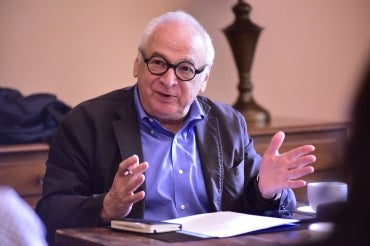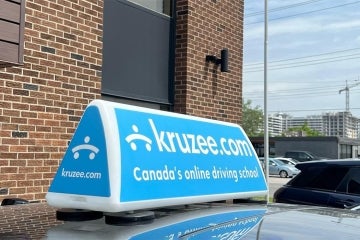The selling of the U.S. election: U of T's Jeffrey Dvorkin explains it all

Published: November 2, 2016
Campaign advertising (and complaining about it) is a standard during election time and with good reason – TV ads reach a lot of people.
But in a shifting media landscape more people are getting their news from Twitter, Facebook and Instagram. In this environment do traditional TV campaign ads still matter? What messages are the campaigns sending people from traditional advertising and from social media?
For more context, writer Don Campbell spoke to Jeffrey Dvorkin, director of the journalism program at U of T Scarborough. He is a former vice-president of news for National Public Radio and a former managing editor with CBC Radio.
Dvorkin will be moderating an upcoming discussion about political advertising at the Hot Docs Theatre on Nov. 6. He shared his insights on the history of campaign advertising and how the current presidential candidates have tried to “sell” themselves to voters.
How has Donald Trump been able to get his message out without relying as much on traditional campaign advertising?
This has never really been done before. Donald Trump has relied far less on traditional campaign advertising than previous Republican campaigns while the Democrats have relied on advertising to pretty much the same extent as they have in the past. What’s unique is that Trump has been able to get on TV consistently either by calling talk shows or open line shows or by saying outrageous things that will get covered by TV network news. This tactic was calculated to be the equivalent of as much as $160 million in free advertising throughout his campaign. At the presidential level, the Republicans have spent $40 million less than the Democrats, but Trump has been able to outspend Hillary Clinton simply by getting on the air. Networks have fallen for this tactic on the assumption that Trump will say something outrageous that will be in the news cycle for the next 24 hours, which helps their ratings.
Historically, how have candidates used campaign advertising?
Political advertising has been an important element in the political landscape since the 1960 presidential election between Kennedy and Nixon, and it’s only been increasing every four years since then. This is especially the case for something called down-market advertising. These are campaign ads that run at the local or state level. They have traditionally been a cash cow for local television stations. In fact, many local TV stations make most of their money for the entire year during the political season. What’s happened this year is that the down-market ads for the local House of Representatives and the Senate have not been the moneymakers they once were.
How has the messaging been different between the two campaigns in this election?
Trump has tapped into a real anxiety among voters. He’s been talking about the hollowing out of the white working class, and he’s tapped into it with a message that’s been at times racist and misogynistic. He’s identified problems but hasn’t offered much in terms of solutions in his messaging. It’s easier for Clinton to counter that message in terms of offering clear policies. This has undermined Trump's message because although there are a lot of pissed-off people, there are a lot of people looking for good ideas.
Trump’s message is appealing to an older television-watching audience, and I think that’s because he’s an entertainer, not a policy person. I think the reason his campaign has failed in general is that he’s appealing to a narrow portion of the American electorate that’s in decline anyways. The demographics in America are changing, and he hasn’t adequately tapped into that.
How have social media and other digital advertising been used in this election?
It’s been an incredibly different kind of election in regard to advertising, and I think it will change the way political campaigns are done in the future. Political advertising at the local level has been targeting older voters because they still watch TV, but younger voters don’t watch TV as much. What Trump has done rather cleverly is that recently he’s been posting on Facebook, trying to directly reach supporters. It will be interesting to see how this translates into numbers, and whether that will work better than buying ads for network or local TV.
But social media and digital culture have changed the landscape, no question. The web has allowed politicians to work around traditional media with their advertising. Big advertising agencies that used to handle media campaigns are being bypassed now by people posting things on Facebook and Twitter. Increasingly, that’s where the eyeballs can be found, not looking at newspaper ads or television ads but social media. Politicians have been looking at ways to circumvent the mainstream media and the internet is providing that outlet.
Are there some influential campaign ads from the past that really resonated with voters in terms of the message they tried to convey?
One really important ad was Ronald Reagan’s "Morning in America." It was very positive and crafted in a way to contrast with how many viewed Jimmy Carter, who was perceived as having a depressing and negative approach to politics. It was during the oil crisis so Jimmy Carter was giving speeches from the White House while wearing a cardigan and telling people to turn down the thermostat. Reagan was a more effective communicator. In the ad, he said, that this isn’t what America is about, that we are problem-solvers. He had an advertising agency develop a message that resonated with people who were actually turned off by Carter’s serious and perhaps more realistic message.
More recently, Barack Obama had a very positive message in his advertising. With his "Yes We Can" message, he tapped into something very positive about how America wants to see itself in the world. That’s why it was so effective, especially given the political climate after the wars in Iraq and Afghanistan and the financial crisis. He said, you know what, there’s no problem we can’t solve. It was in many ways a direct Democrat version of "Morning in America."
How would you rate the media’s coverage of this election so far?
Overall, it hasn’t been great. There’s been a trend of focusing on the race itself via the polls, rather than looking at the party or the candidates’ platform. One reason for this is that news outlets are relying more on polling data than ever before. There are fewer field reporters doing the legwork of figuring out what the policies and ideas are. That’s not happening anymore. The economic reality for most news outlets is that they’re lowering the quality of their content, and the obvious example of this is crunching data to provide content for media organizations.
Some are doing a better job like The Washington Post, The Wall Street Journal and The New York Times, which are doing tremendous research into what the electorate want, what they’re thinking, and to what extent they’re responding to the ideas of Clinton and Trump. Other media, especially TV, is looking for a version of political click bait. Every time Trump opens his mouth he’s providing content, and there’s a ratings bump, but often there’s no context provided for it. This is the part of reality TV that Trump is so good at, but overall it’s a disservice to the American electorate.
Don Campbell is a writer with the University of Toronto Scarborough



